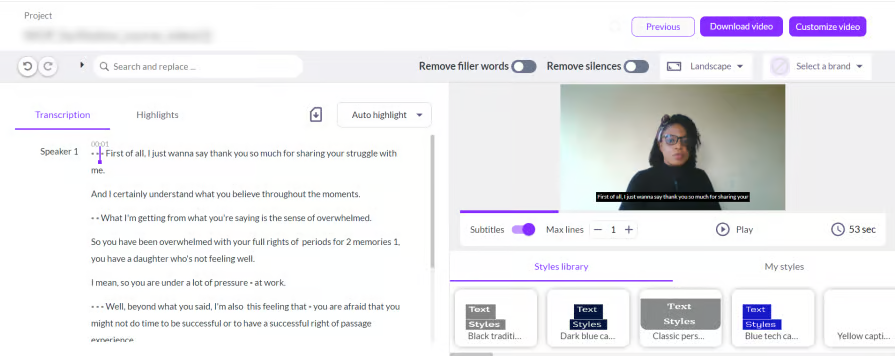“We’re never going there. Creativity is made, not generated.”
– Procreate via X (formerly Twitter)
In an era where AI has become the buzzword of the tech industry, companies are grappling with how to position their products in an AI-driven market. AI’s capability to automate, optimize, and create has revolutionized many sectors, but not without controversy.
In a recent video posted on X, James Cuda, Procreate CEO, took a stance against the prevailing generative AI trend:
“I don’t like what’s happening in the industry, and I don’t like what it’s doing to artists. We’re not going to be introducing any generative AI into our products. Our products are always designed and developed with the idea that a human will be creating something.”
His statement highlights the increasingly prevalent tension that comes with the challenge of leveraging AI’s capabilities while maintaining authenticity and creativity.
Can a product succeed without embracing the AI revolution, or does it risk being left behind? This article discusses how AI can be thoughtfully integrated into product strategy.
Artificial intelligence (AI) dates back to the 1950s, when humans first built computers for calculations. AI in product design began sometime later with basic tools for automating repetitive tasks, such as data entry, simple calculations, and basic process management.
Fast forward to the recent decade, when AI has become deeply embedded in our lives. These AI systems are designed and trained using machine learning models to perform specific tasks or a set of tasks.
In many ways, AI has had a positive impact on product management. For example, Galileo AI helps product managers by automatically analyzing user sessions to identify key areas where users struggle. It surfaces critical issues and presents insights in natural language, enabling product managers to quickly understand user pain points and make data-driven decisions.
However, there are also many valid concerns about the potential negative impact AI might have on the way we work and think. Let’s get into the discussion in more detail.
While AI systems today can produce a wide range of outputs and appear highly versatile, they’re still limited to the tasks they were trained for. They lack general understanding, reasoning, and adaptability.
Even though AI systems can generate human-like text or images, they don’t possess true understanding or consciousness, nor can they transfer their abilities to unrelated tasks outside the training. An AI tool follows patterns and rules learned from data rather than possessing a human-like intelligence.
The debate over AI’s impact on creativity reflects the concerns our society has for technology. While AI offers benefits in product design, it also raises legitimate concerns. Let’s take a look at some of the pros and cons of AI in product design.
Without a doubt, AI is revolutionizing product design. Product designers can focus on innovation and user-centered design with the support of AI tools. Let’s delve into how we as product managers can take advantage of AI.
AI can automate routine and time-consuming tasks, such as removing image backgrounds:

AI can also resize images, format layouts, and arrange design elements. It frees up product designers’ time and allows them to focus more on the conceptual and expressive aspects of their work.
AI tools can extract data from various sources including structured and unstructured data such as texts or images. Natural language processing (NLP) models help product teams analyze customer feedback and social media posts to gauge customer’s feelings towards the product.
With these AI systems, we can collect data, process it, and make decisions based on the insights AI helps us reveal.
Enhancing product accessibility empowers people to learn and achieve more. Leveraging AI to improve accessibility enables us to cater to diverse user needs:

Some accessibility features powered by AI are voice recognition, text-to-speech, and speech-to-text. These features have transformed the way humans interact with machines.
Other AI assistive technologies, such as AI-based translation, captioning, and screen readers, invite a broader audience to enjoy the benefits of technology.
Generative AI can serve as a powerful tool to generate inspiration for art, music, and text that artists can then refine and build upon. A good use case is that AI can make “suggestions” on color palettes for a visual design based on quality photos in the open library.
In the iterative process, generative AI can rapidly generate and refine concepts based on feedback. It can quickly help the product team to prototype and explore the solutions.
However, use cases for generative AI in creative disciplines should be handled with care. We’ll address this in the next section.
While AI can be a powerful tool for enhancing creativity, there are some potential pitfalls AI may introduce to the product design process. Understanding these concerns can help us better balance AI’s benefits with the need to preserve and nurture human creativity.
Excessive reliance on AI could lead to a decline in human creativity. When people become too dependent on AI-generated solutions and ideas, we let go of the opportunities to tease our brains, and this could potentially stifle our original thoughts.
As a result, we might see a decrease in the richness and diversity of ideas, as generative AI is not designed for creating unconventional or novel concepts.
Design homogenization refers to the trend where products, services, or interfaces across different brands look and feel similar. Globalization, standard design frameworks, and the use of similar tools are reasons why many products are similar to one another these days:

Of course, this is sometimes a strategic design choice to help users navigate products more efficiently. However, there’s also a prevailing concern that design homogeneity can sometimes take the life and delight out of the customer experience. Petco’s controversial logo redesign is a good example of this:

Generative AI accelerates the intermixing process, even though design homogenization is not a new phenomenon. When creators use AI tools to generate art and other content, that generated material becomes the training data for later AI models. This feedback loop can ultimately lead to the homogenization of creative outputs.
AI model collapse is a concept that describes the phenomenon where AI models are trained on data that includes outputs from other AI models, particularly generative AI systems. This recursive training process can lead to a quality decrease in the model’s outputs.
Suppose the training data for all the generative AI models becomes increasingly synthetic and less representative of the real world. In that case, it can cause the model to generate less accurate, less diverse, and potentially biased results.
Intellectual property, authorship, and ownership are hard to determine when AI is involved in creative processes. If an AI generates a piece of image, based on content created by humans, who owns the rights to it?
Additionally, AI models are often trained on existing works without the original creators’ consent, raising concerns about plagiarism and exploitation.
The partnership between humans and machines will deepen as AI continues to evolve. AI provides tools and insights that enable human creativity to flourish, but we still need to be mindful of how we collaborate with AI to create impactful work.
The essence of creativity, which includes original thought, emotional depth, and cultural context, remains inherently human. Despite AI’s growing sophistication, it cannot — and some say it should not — understand the nuance of cultural references, humor, and emotions, which are the fundamentals of true creativity.

We can use AI for data-intensive tasks. It assists with brainstorming, rapid prototyping, and automation. With the time and effort saved from the tedious repetitive work, we can concentrate on strategic decision-making, innovation, problem-solving, and creative thinking.
Product teams must develop a clear understanding of their customers and thoroughly validate the problem statement before jumping to AI as a solution. Many products have incorporated AI into their offerings to keep up with the latest technology advancements. However, these AI tools may be solving a non-existent problem.
In some scenarios, the AI tool introduces complexity into the user journey without necessarily adding value for customers. This can lead to a misalignment between the product and the actual needs of users, ultimately resulting in wasted resources.
There are many methods to position your product in a competitive market. To expand on the strategies with an AI-focused perspective, here are some approaches:
From user experience to content generation, product teams are navigating where AI truly adds value and where it might undermine the creative processes. The debate is sometimes more philosophical than technical, questioning what role AI should play.
With the technology of today, human creativity is still irreplaceable. As a PM, be sure to focus on who you are solving the issues for, what challenges they face, and how your product can address the challenges, whether through AI solutions or otherwise.

LogRocket identifies friction points in the user experience so you can make informed decisions about product and design changes that must happen to hit your goals.
With LogRocket, you can understand the scope of the issues affecting your product and prioritize the changes that need to be made. LogRocket simplifies workflows by allowing Engineering, Product, UX, and Design teams to work from the same data as you, eliminating any confusion about what needs to be done.
Get your teams on the same page — try LogRocket today.

A practical framework for PMs to use AI in ideation without sacrificing judgment, strategy, or decision quality.

A practical five minute revenue estimation method to help product managers compare ideas, drop low impact features, and prioritize smarter.

A practical guide for PMs who want to stop being bottlenecks, delegate smarter, and lead teams effectively with a clear ownership framework.

Stop letting unreliable data block features. Treat data as inventory to track quality, ownership, and ship with confidence.